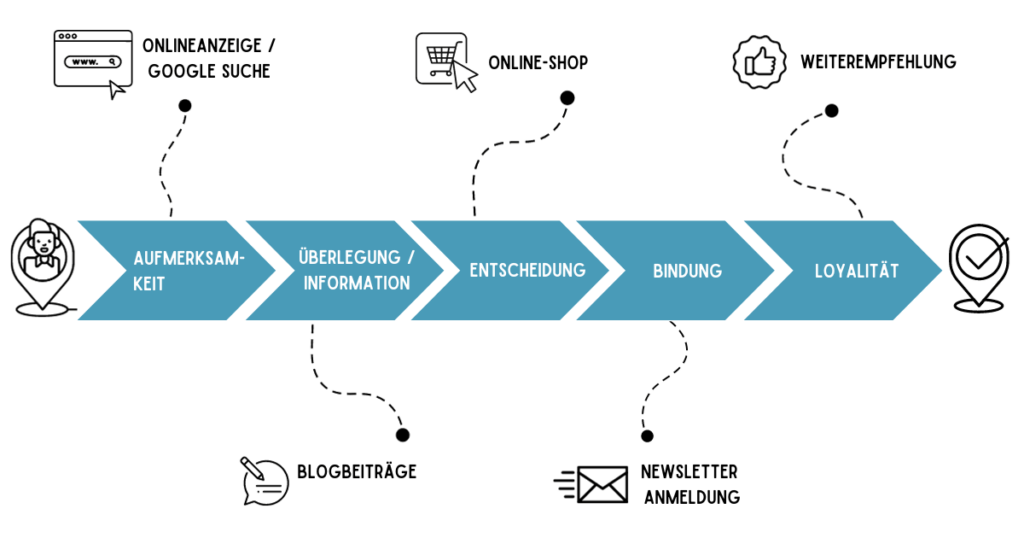
Customer Experience Marketing
User-friendliness in terms of website design
- adojo GmbH
The digitization revolutionized marketing. Today, customers have more options than ever before, and their expectations for website usability are accordingly high. Websites are not just showcases for products or services; they are also crucial factors in the customer journey. Customer Experience Marketing focuses on optimizing the interaction between customers and companies across various digital touchpoints along the customer journey. In this context, the user-friendliness of a website plays a crucial role in shaping a positive customer experience. Companies that prioritize excellent customer experience understand that the design of their website is of utmost importance. In this blog post, we take a closer look at the importance of user-friendliness in website design along the customer journey.
Understanding Customer Experience
Customer experience encompasses all the impressions a customer gathers throughout their interactions with a company. These impressions can be positive or negative and significantly influence customer loyalty and purchasing decisions. Therefore, a positive customer experience is crucial for retaining customers in the long term and attracting new ones.
The success of digital campaigns is highly dependent on the degree of user-friendliness on the website or in the webshop.

Understanding the Customer Journey
Before delving into website design details, it’s essential to understand the customer journey. The customer journey describes the path a customer takes from the initial interaction with a company to the purchase decision and beyond. This journey encompasses various touchpoints, from the initial discovery of a product to the purchase process and subsequent customer support. These touchpoints can include website visits, social media, email marketing, and more. Each of these digital touchpoints offers an opportunity to create positive customer experiences and build trust with customers, thus fostering long-term relationships.

Why User-Friendliness Matters?
User-friendliness, also known as usability, refers to how easily users can navigate a website or application. A user-friendly design ensures that visitors can quickly and easily find what they’re looking for and that the website can be used intuitively and without significant effort. User-friendliness is crucial because it significantly impacts how customers perceive your website and, by extension, your company.
A user-friendly website offers numerous benefits:
Improves brand image
Improves brand image: A well-designed, user-friendly website conveys professionalism and care for customers. A positive first impression can strengthen the brand image and gain customer trust.
Enhances customer loyalty
A positive user experience on your website leads to satisfied customers. This can positively impact your reputation and customer retention.
Increased conversion rates
Increases conversion rates: When a website is easy to navigate and meets user needs, customers will spend more time on the site. This increases the likelihood of them engaging with the company and ultimately becoming customers. Moreover, customers who easily find products and experience a smooth purchasing process are more likely to revisit the website and make purchases from the company.
Reduces bounce rates
A poorly designed website or a confusing menu structure can frustrate users and often leads to a high bounce rate. If visitors struggle to find the information they need, they are likely to leave the website. A user-friendly website minimizes this frustration and keeps users on the site longer.
Companies that invest in the user-friendliness of their digital touchpoints are investing in long-term success and strengthening their position in today’s competitive online market. To optimize user-friendliness in website design along the customer journey, it’s essential to consider the needs and expectations of customers at every stage of the journey. In an era where customers can switch between different options in seconds, website design is a critical factor in attracting and retaining customers’ attention. Careful planning and adjustment of the design at every step of the customer journey are essential to ensure that customer needs are met and a positive customer experience is created.
Best Practices for User-Friendly Web Design
How can you create a user-friendly website? Here are some best practices:
Clear navigation
Navigation should be intuitive. Ensure a clear menu structure, meaningful content arrangement, and visible call-to-action elements to help visitors orient themselves. Customers should know what to do next, whether it’s to gather more information, make a purchase, sign up for the newsletter, or contact customer service.
Appealing visual design
The visual appearance of the website should reflect the brand. Colors, fonts, and images should align with the brand identity. An attractive and consistent design across all digital touchpoints contributes to brand credibility and recognition.
Fast loading times
Fast loading times: Optimize your website’s speed to ensure that visitors are not put off by long loading times.
Responsives Design
Ensure that your website works as well on mobile devices as it does on desktops. In the age of smartphones, mobile usability is crucial
Accessibility
An accessible website is essential for all users, including those with disabilities. Ensure that your website is accessible to people with various abilities by designing for screen readers and other assistive technologies.
High-quality content
The content of the website should be informative, up-to-date, and relevant. Good content not only helps build customer trust but can also aid in search engine optimization (SEO) to generate more organic traffic.
Continuous improvement of the customer experience
Die Gestaltung einer benutzerfreundlichen Website ist jedoch nicht einmalig abgeschlossen. Es ist ein laufender Prozess, der kontinuierliche Überwachung und Anpassung erfordert. Die Nutzung von Analysen und Feedback von Benutzern ist entscheidend, um Schwachstellen zu identifizieren und das Website-Design kontinuierlich zu verbessern. Dies ist entscheidend, um sicherzustellen, dass Ihre Website den sich ändernden Erwartungen der Kunden gerecht wird.
In summary, website design is crucial for Customer Experience Marketing. User-friendliness is particularly critical for enhancing the customer experience because a user-friendly website creates a positive first impression, supports navigation, and accompanies customers throughout their journey. Thus, the website contributes to strengthening customer trust, increasing customer loyalty, and ultimately promoting business success.
Our Service Package for Customer Experience Marketing Overview
- Website Analysis
- SEO Optimization
- Creation of Editorial Content
- Management of Google Ads Campaigns
- Success Monitoring through Google Analytics
